Health Policy Analysis: Policy Frameworks in Healthcare Provision
VerifiedAdded on 2022/08/16
|14
|3781
|21
Report
AI Summary
This report provides an analysis of health policies, particularly focusing on the social determinants of health and the frameworks within which these policies operate. The introduction highlights the importance of political awareness and communication skills in shaping effective health policies, emphasizing the role of various governmental levels and economic structures. The discussion section delves into the standardization of healthcare activities through clinical policies and procedures, using the National Palliative Care Strategy in Australia as an example. It examines the strategy's goals, objectives, and implementation plan, including the reduction of smoking rates and the National Drug Strategy. The report also explores the evolution of mental health strategies, focusing on recovery-oriented approaches and the Fourth National Mental Health Strategy. The report analyzes different policies, including those related to palliative care, smoking cessation, and mental health, providing a comprehensive overview of healthcare policy development and its impact on various populations. The report uses the Australian Policy Cycle to frame the analysis and the Analysts Toolkit to critically analyze and discuss health policy development.
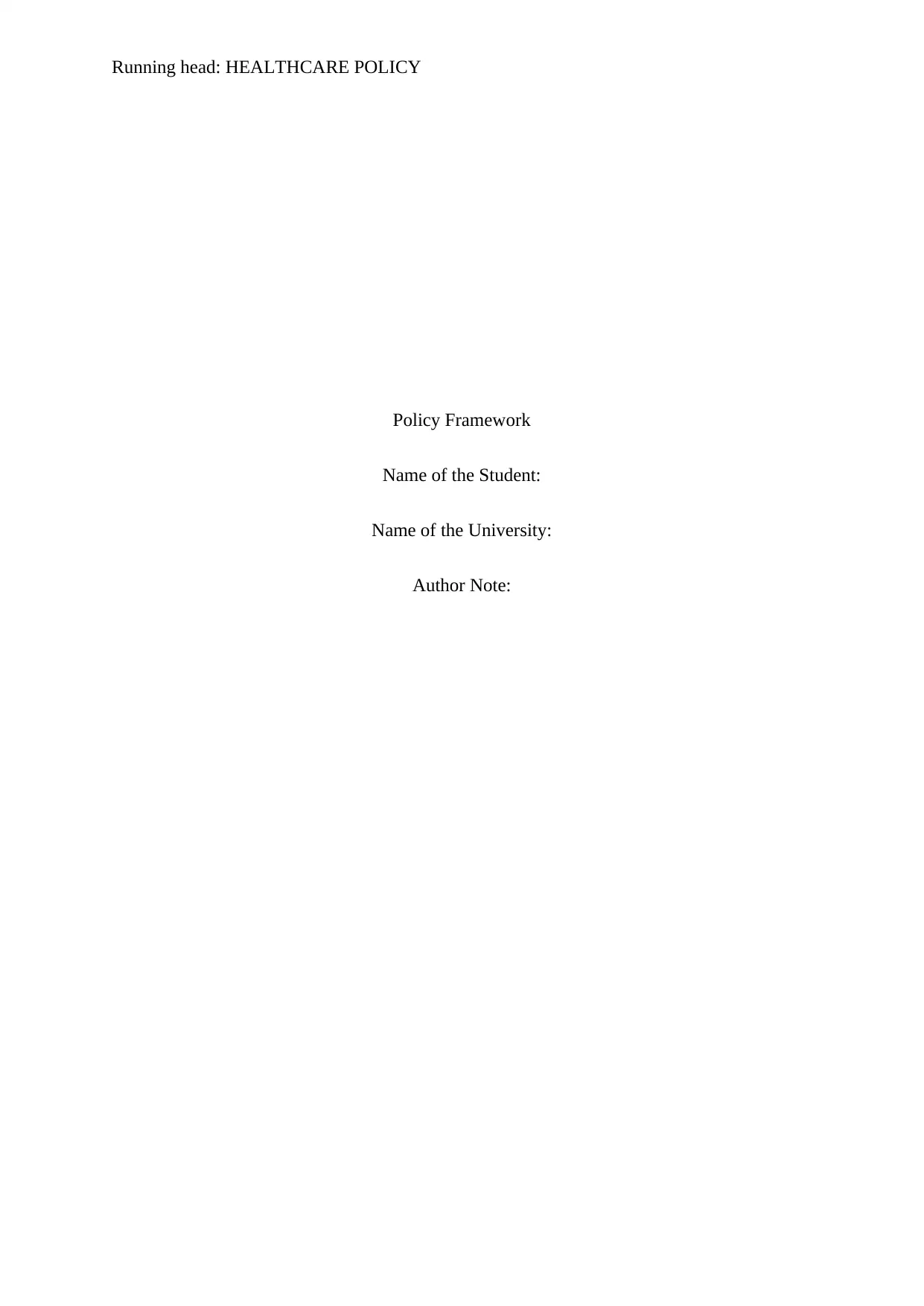
Running head: HEALTHCARE POLICY
Policy Framework
Name of the Student:
Name of the University:
Author Note:
Policy Framework
Name of the Student:
Name of the University:
Author Note:
Paraphrase This Document
Need a fresh take? Get an instant paraphrase of this document with our AI Paraphraser
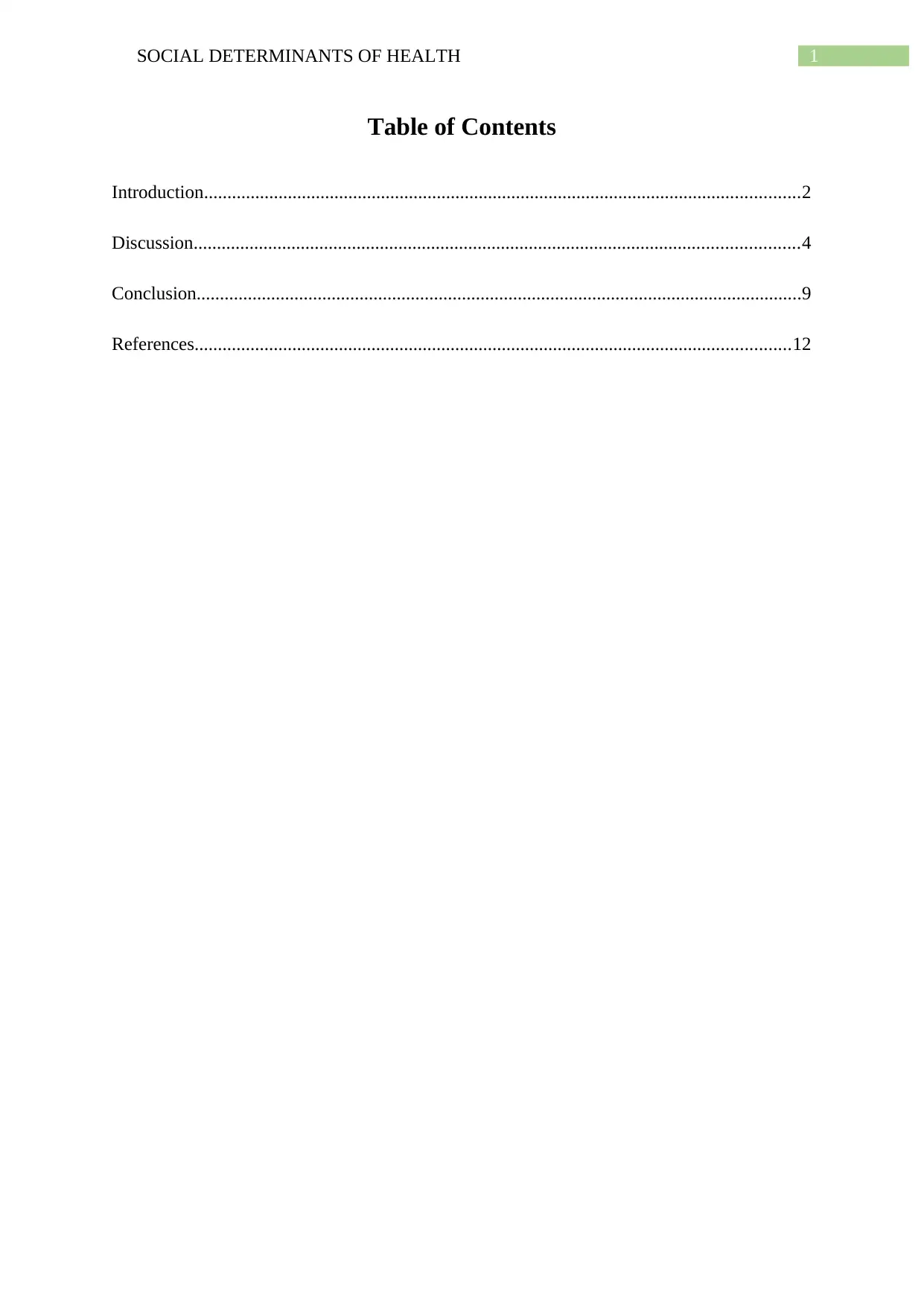
1SOCIAL DETERMINANTS OF HEALTH
Table of Contents
Introduction................................................................................................................................2
Discussion..................................................................................................................................4
Conclusion..................................................................................................................................9
References................................................................................................................................12
Table of Contents
Introduction................................................................................................................................2
Discussion..................................................................................................................................4
Conclusion..................................................................................................................................9
References................................................................................................................................12
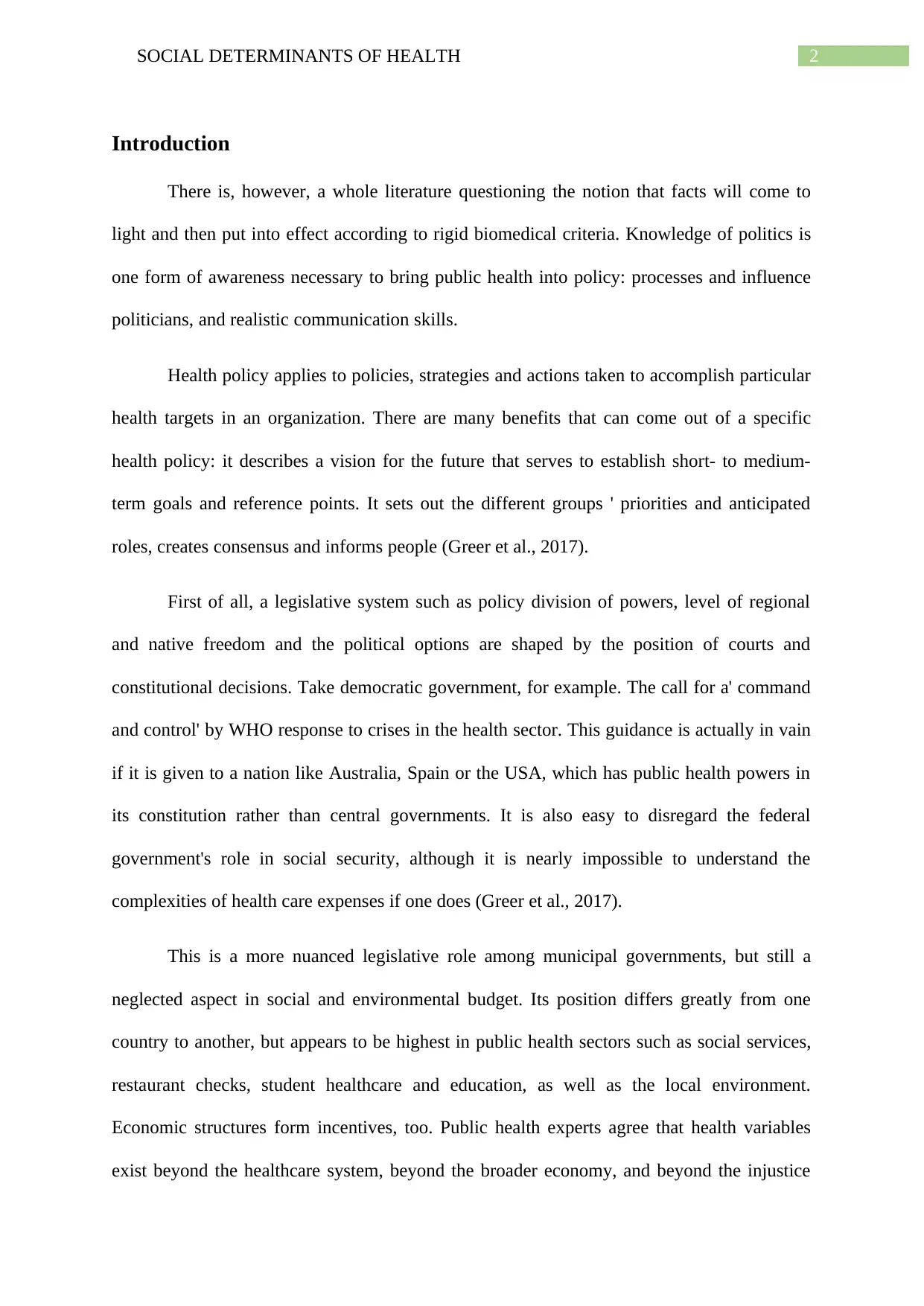
2SOCIAL DETERMINANTS OF HEALTH
Introduction
There is, however, a whole literature questioning the notion that facts will come to
light and then put into effect according to rigid biomedical criteria. Knowledge of politics is
one form of awareness necessary to bring public health into policy: processes and influence
politicians, and realistic communication skills.
Health policy applies to policies, strategies and actions taken to accomplish particular
health targets in an organization. There are many benefits that can come out of a specific
health policy: it describes a vision for the future that serves to establish short- to medium-
term goals and reference points. It sets out the different groups ' priorities and anticipated
roles, creates consensus and informs people (Greer et al., 2017).
First of all, a legislative system such as policy division of powers, level of regional
and native freedom and the political options are shaped by the position of courts and
constitutional decisions. Take democratic government, for example. The call for a' command
and control' by WHO response to crises in the health sector. This guidance is actually in vain
if it is given to a nation like Australia, Spain or the USA, which has public health powers in
its constitution rather than central governments. It is also easy to disregard the federal
government's role in social security, although it is nearly impossible to understand the
complexities of health care expenses if one does (Greer et al., 2017).
This is a more nuanced legislative role among municipal governments, but still a
neglected aspect in social and environmental budget. Its position differs greatly from one
country to another, but appears to be highest in public health sectors such as social services,
restaurant checks, student healthcare and education, as well as the local environment.
Economic structures form incentives, too. Public health experts agree that health variables
exist beyond the healthcare system, beyond the broader economy, and beyond the injustice
Introduction
There is, however, a whole literature questioning the notion that facts will come to
light and then put into effect according to rigid biomedical criteria. Knowledge of politics is
one form of awareness necessary to bring public health into policy: processes and influence
politicians, and realistic communication skills.
Health policy applies to policies, strategies and actions taken to accomplish particular
health targets in an organization. There are many benefits that can come out of a specific
health policy: it describes a vision for the future that serves to establish short- to medium-
term goals and reference points. It sets out the different groups ' priorities and anticipated
roles, creates consensus and informs people (Greer et al., 2017).
First of all, a legislative system such as policy division of powers, level of regional
and native freedom and the political options are shaped by the position of courts and
constitutional decisions. Take democratic government, for example. The call for a' command
and control' by WHO response to crises in the health sector. This guidance is actually in vain
if it is given to a nation like Australia, Spain or the USA, which has public health powers in
its constitution rather than central governments. It is also easy to disregard the federal
government's role in social security, although it is nearly impossible to understand the
complexities of health care expenses if one does (Greer et al., 2017).
This is a more nuanced legislative role among municipal governments, but still a
neglected aspect in social and environmental budget. Its position differs greatly from one
country to another, but appears to be highest in public health sectors such as social services,
restaurant checks, student healthcare and education, as well as the local environment.
Economic structures form incentives, too. Public health experts agree that health variables
exist beyond the healthcare system, beyond the broader economy, and beyond the injustice
⊘ This is a preview!⊘
Do you want full access?
Subscribe today to unlock all pages.

Trusted by 1+ million students worldwide
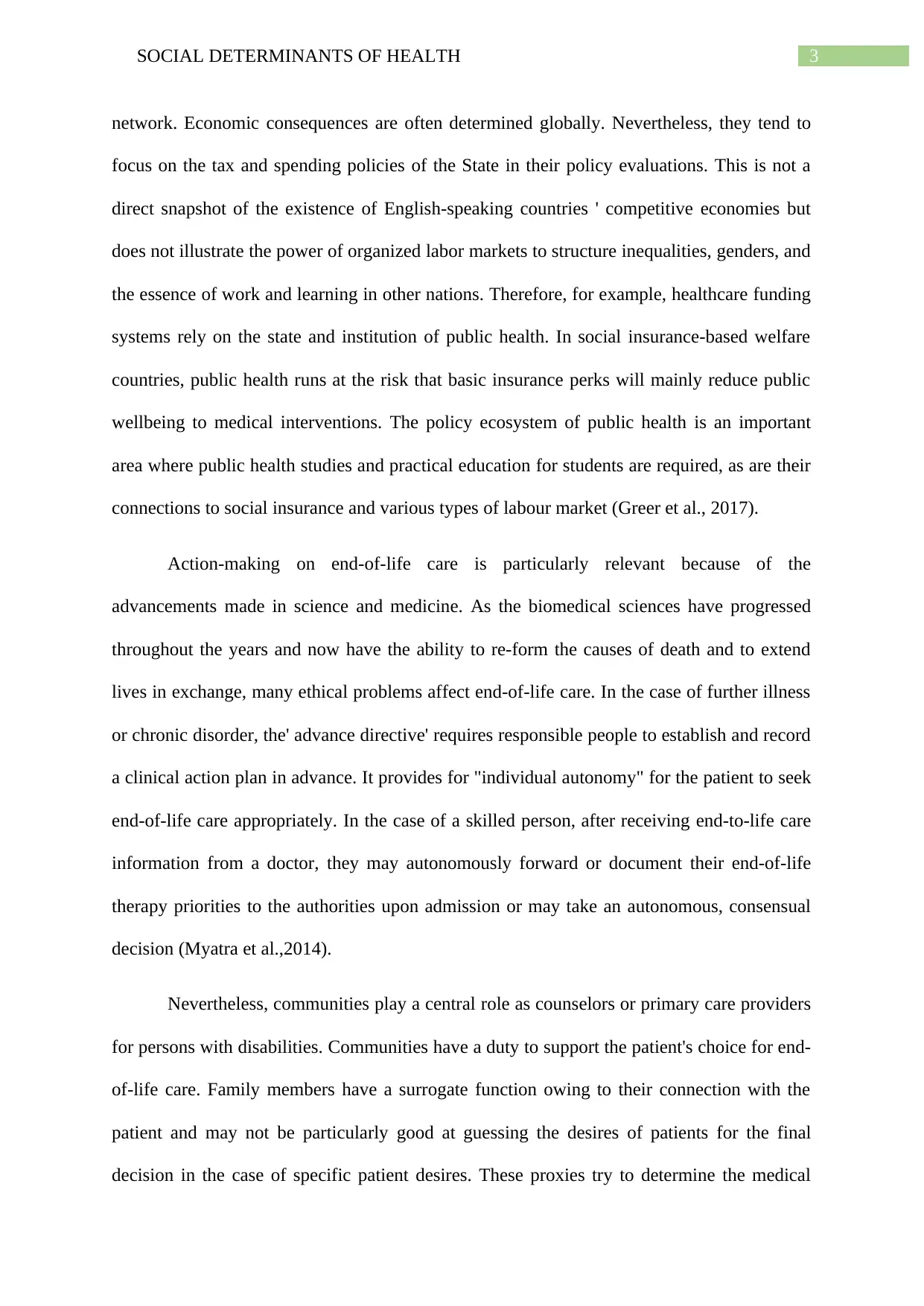
3SOCIAL DETERMINANTS OF HEALTH
network. Economic consequences are often determined globally. Nevertheless, they tend to
focus on the tax and spending policies of the State in their policy evaluations. This is not a
direct snapshot of the existence of English-speaking countries ' competitive economies but
does not illustrate the power of organized labor markets to structure inequalities, genders, and
the essence of work and learning in other nations. Therefore, for example, healthcare funding
systems rely on the state and institution of public health. In social insurance-based welfare
countries, public health runs at the risk that basic insurance perks will mainly reduce public
wellbeing to medical interventions. The policy ecosystem of public health is an important
area where public health studies and practical education for students are required, as are their
connections to social insurance and various types of labour market (Greer et al., 2017).
Action-making on end-of-life care is particularly relevant because of the
advancements made in science and medicine. As the biomedical sciences have progressed
throughout the years and now have the ability to re-form the causes of death and to extend
lives in exchange, many ethical problems affect end-of-life care. In the case of further illness
or chronic disorder, the' advance directive' requires responsible people to establish and record
a clinical action plan in advance. It provides for "individual autonomy" for the patient to seek
end-of-life care appropriately. In the case of a skilled person, after receiving end-to-life care
information from a doctor, they may autonomously forward or document their end-of-life
therapy priorities to the authorities upon admission or may take an autonomous, consensual
decision (Myatra et al.,2014).
Nevertheless, communities play a central role as counselors or primary care providers
for persons with disabilities. Communities have a duty to support the patient's choice for end-
of-life care. Family members have a surrogate function owing to their connection with the
patient and may not be particularly good at guessing the desires of patients for the final
decision in the case of specific patient desires. These proxies try to determine the medical
network. Economic consequences are often determined globally. Nevertheless, they tend to
focus on the tax and spending policies of the State in their policy evaluations. This is not a
direct snapshot of the existence of English-speaking countries ' competitive economies but
does not illustrate the power of organized labor markets to structure inequalities, genders, and
the essence of work and learning in other nations. Therefore, for example, healthcare funding
systems rely on the state and institution of public health. In social insurance-based welfare
countries, public health runs at the risk that basic insurance perks will mainly reduce public
wellbeing to medical interventions. The policy ecosystem of public health is an important
area where public health studies and practical education for students are required, as are their
connections to social insurance and various types of labour market (Greer et al., 2017).
Action-making on end-of-life care is particularly relevant because of the
advancements made in science and medicine. As the biomedical sciences have progressed
throughout the years and now have the ability to re-form the causes of death and to extend
lives in exchange, many ethical problems affect end-of-life care. In the case of further illness
or chronic disorder, the' advance directive' requires responsible people to establish and record
a clinical action plan in advance. It provides for "individual autonomy" for the patient to seek
end-of-life care appropriately. In the case of a skilled person, after receiving end-to-life care
information from a doctor, they may autonomously forward or document their end-of-life
therapy priorities to the authorities upon admission or may take an autonomous, consensual
decision (Myatra et al.,2014).
Nevertheless, communities play a central role as counselors or primary care providers
for persons with disabilities. Communities have a duty to support the patient's choice for end-
of-life care. Family members have a surrogate function owing to their connection with the
patient and may not be particularly good at guessing the desires of patients for the final
decision in the case of specific patient desires. These proxies try to determine the medical
Paraphrase This Document
Need a fresh take? Get an instant paraphrase of this document with our AI Paraphraser
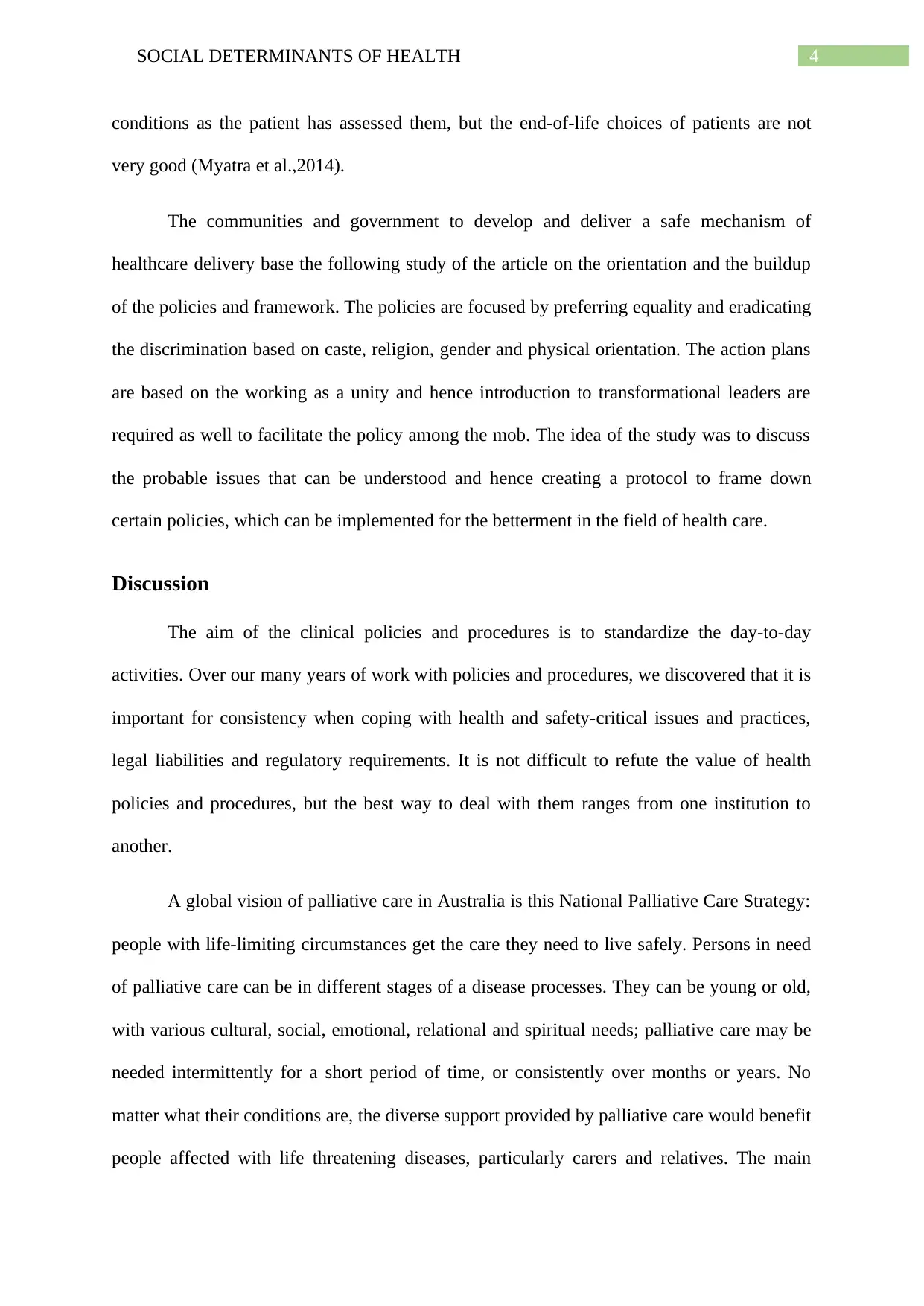
4SOCIAL DETERMINANTS OF HEALTH
conditions as the patient has assessed them, but the end-of-life choices of patients are not
very good (Myatra et al.,2014).
The communities and government to develop and deliver a safe mechanism of
healthcare delivery base the following study of the article on the orientation and the buildup
of the policies and framework. The policies are focused by preferring equality and eradicating
the discrimination based on caste, religion, gender and physical orientation. The action plans
are based on the working as a unity and hence introduction to transformational leaders are
required as well to facilitate the policy among the mob. The idea of the study was to discuss
the probable issues that can be understood and hence creating a protocol to frame down
certain policies, which can be implemented for the betterment in the field of health care.
Discussion
The aim of the clinical policies and procedures is to standardize the day-to-day
activities. Over our many years of work with policies and procedures, we discovered that it is
important for consistency when coping with health and safety-critical issues and practices,
legal liabilities and regulatory requirements. It is not difficult to refute the value of health
policies and procedures, but the best way to deal with them ranges from one institution to
another.
A global vision of palliative care in Australia is this National Palliative Care Strategy:
people with life-limiting circumstances get the care they need to live safely. Persons in need
of palliative care can be in different stages of a disease processes. They can be young or old,
with various cultural, social, emotional, relational and spiritual needs; palliative care may be
needed intermittently for a short period of time, or consistently over months or years. No
matter what their conditions are, the diverse support provided by palliative care would benefit
people affected with life threatening diseases, particularly carers and relatives. The main
conditions as the patient has assessed them, but the end-of-life choices of patients are not
very good (Myatra et al.,2014).
The communities and government to develop and deliver a safe mechanism of
healthcare delivery base the following study of the article on the orientation and the buildup
of the policies and framework. The policies are focused by preferring equality and eradicating
the discrimination based on caste, religion, gender and physical orientation. The action plans
are based on the working as a unity and hence introduction to transformational leaders are
required as well to facilitate the policy among the mob. The idea of the study was to discuss
the probable issues that can be understood and hence creating a protocol to frame down
certain policies, which can be implemented for the betterment in the field of health care.
Discussion
The aim of the clinical policies and procedures is to standardize the day-to-day
activities. Over our many years of work with policies and procedures, we discovered that it is
important for consistency when coping with health and safety-critical issues and practices,
legal liabilities and regulatory requirements. It is not difficult to refute the value of health
policies and procedures, but the best way to deal with them ranges from one institution to
another.
A global vision of palliative care in Australia is this National Palliative Care Strategy:
people with life-limiting circumstances get the care they need to live safely. Persons in need
of palliative care can be in different stages of a disease processes. They can be young or old,
with various cultural, social, emotional, relational and spiritual needs; palliative care may be
needed intermittently for a short period of time, or consistently over months or years. No
matter what their conditions are, the diverse support provided by palliative care would benefit
people affected with life threatening diseases, particularly carers and relatives. The main
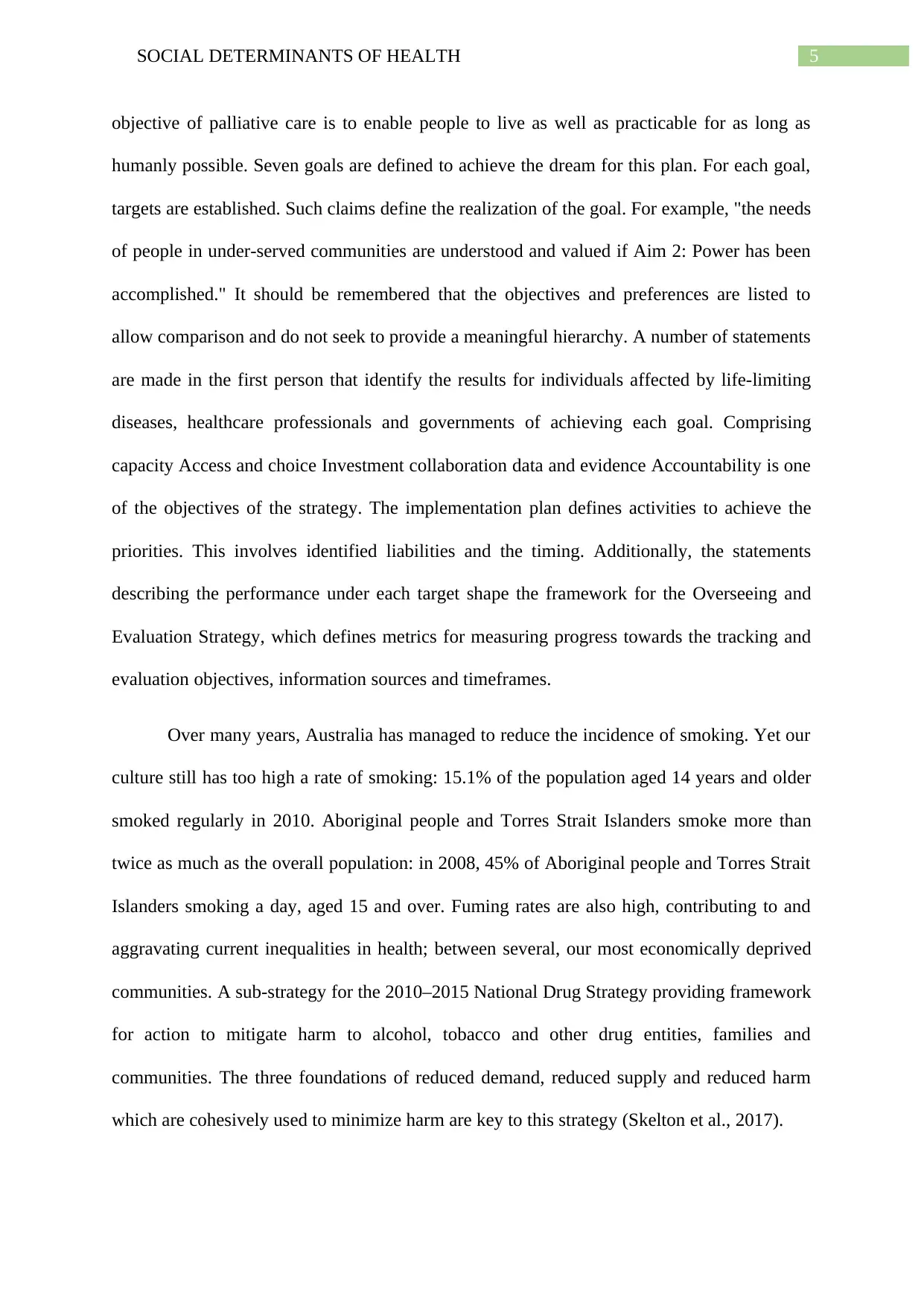
5SOCIAL DETERMINANTS OF HEALTH
objective of palliative care is to enable people to live as well as practicable for as long as
humanly possible. Seven goals are defined to achieve the dream for this plan. For each goal,
targets are established. Such claims define the realization of the goal. For example, "the needs
of people in under-served communities are understood and valued if Aim 2: Power has been
accomplished." It should be remembered that the objectives and preferences are listed to
allow comparison and do not seek to provide a meaningful hierarchy. A number of statements
are made in the first person that identify the results for individuals affected by life-limiting
diseases, healthcare professionals and governments of achieving each goal. Comprising
capacity Access and choice Investment collaboration data and evidence Accountability is one
of the objectives of the strategy. The implementation plan defines activities to achieve the
priorities. This involves identified liabilities and the timing. Additionally, the statements
describing the performance under each target shape the framework for the Overseeing and
Evaluation Strategy, which defines metrics for measuring progress towards the tracking and
evaluation objectives, information sources and timeframes.
Over many years, Australia has managed to reduce the incidence of smoking. Yet our
culture still has too high a rate of smoking: 15.1% of the population aged 14 years and older
smoked regularly in 2010. Aboriginal people and Torres Strait Islanders smoke more than
twice as much as the overall population: in 2008, 45% of Aboriginal people and Torres Strait
Islanders smoking a day, aged 15 and over. Fuming rates are also high, contributing to and
aggravating current inequalities in health; between several, our most economically deprived
communities. A sub-strategy for the 2010–2015 National Drug Strategy providing framework
for action to mitigate harm to alcohol, tobacco and other drug entities, families and
communities. The three foundations of reduced demand, reduced supply and reduced harm
which are cohesively used to minimize harm are key to this strategy (Skelton et al., 2017).
objective of palliative care is to enable people to live as well as practicable for as long as
humanly possible. Seven goals are defined to achieve the dream for this plan. For each goal,
targets are established. Such claims define the realization of the goal. For example, "the needs
of people in under-served communities are understood and valued if Aim 2: Power has been
accomplished." It should be remembered that the objectives and preferences are listed to
allow comparison and do not seek to provide a meaningful hierarchy. A number of statements
are made in the first person that identify the results for individuals affected by life-limiting
diseases, healthcare professionals and governments of achieving each goal. Comprising
capacity Access and choice Investment collaboration data and evidence Accountability is one
of the objectives of the strategy. The implementation plan defines activities to achieve the
priorities. This involves identified liabilities and the timing. Additionally, the statements
describing the performance under each target shape the framework for the Overseeing and
Evaluation Strategy, which defines metrics for measuring progress towards the tracking and
evaluation objectives, information sources and timeframes.
Over many years, Australia has managed to reduce the incidence of smoking. Yet our
culture still has too high a rate of smoking: 15.1% of the population aged 14 years and older
smoked regularly in 2010. Aboriginal people and Torres Strait Islanders smoke more than
twice as much as the overall population: in 2008, 45% of Aboriginal people and Torres Strait
Islanders smoking a day, aged 15 and over. Fuming rates are also high, contributing to and
aggravating current inequalities in health; between several, our most economically deprived
communities. A sub-strategy for the 2010–2015 National Drug Strategy providing framework
for action to mitigate harm to alcohol, tobacco and other drug entities, families and
communities. The three foundations of reduced demand, reduced supply and reduced harm
which are cohesively used to minimize harm are key to this strategy (Skelton et al., 2017).
⊘ This is a preview!⊘
Do you want full access?
Subscribe today to unlock all pages.

Trusted by 1+ million students worldwide
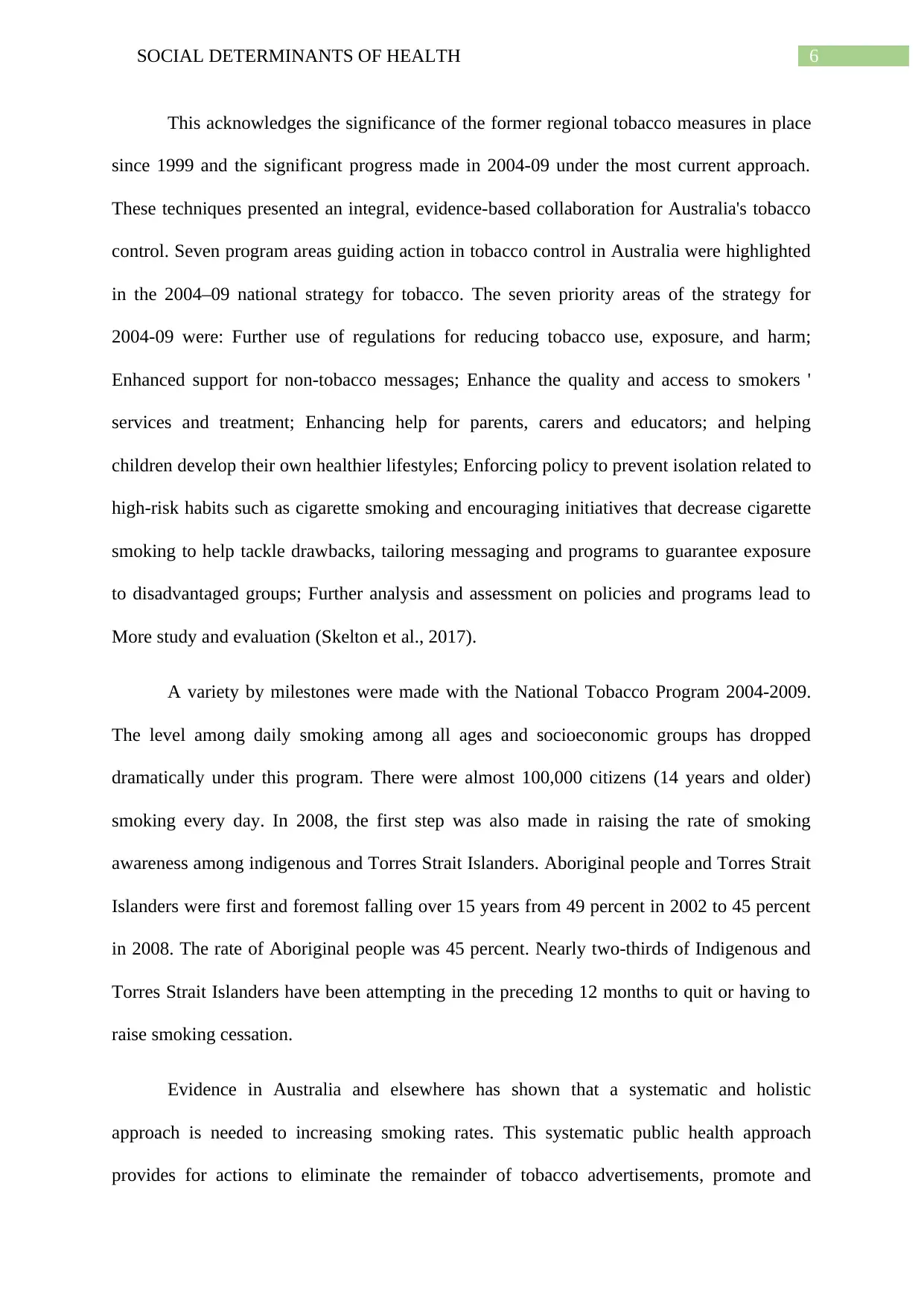
6SOCIAL DETERMINANTS OF HEALTH
This acknowledges the significance of the former regional tobacco measures in place
since 1999 and the significant progress made in 2004-09 under the most current approach.
These techniques presented an integral, evidence-based collaboration for Australia's tobacco
control. Seven program areas guiding action in tobacco control in Australia were highlighted
in the 2004–09 national strategy for tobacco. The seven priority areas of the strategy for
2004-09 were: Further use of regulations for reducing tobacco use, exposure, and harm;
Enhanced support for non-tobacco messages; Enhance the quality and access to smokers '
services and treatment; Enhancing help for parents, carers and educators; and helping
children develop their own healthier lifestyles; Enforcing policy to prevent isolation related to
high-risk habits such as cigarette smoking and encouraging initiatives that decrease cigarette
smoking to help tackle drawbacks, tailoring messaging and programs to guarantee exposure
to disadvantaged groups; Further analysis and assessment on policies and programs lead to
More study and evaluation (Skelton et al., 2017).
A variety by milestones were made with the National Tobacco Program 2004-2009.
The level among daily smoking among all ages and socioeconomic groups has dropped
dramatically under this program. There were almost 100,000 citizens (14 years and older)
smoking every day. In 2008, the first step was also made in raising the rate of smoking
awareness among indigenous and Torres Strait Islanders. Aboriginal people and Torres Strait
Islanders were first and foremost falling over 15 years from 49 percent in 2002 to 45 percent
in 2008. The rate of Aboriginal people was 45 percent. Nearly two-thirds of Indigenous and
Torres Strait Islanders have been attempting in the preceding 12 months to quit or having to
raise smoking cessation.
Evidence in Australia and elsewhere has shown that a systematic and holistic
approach is needed to increasing smoking rates. This systematic public health approach
provides for actions to eliminate the remainder of tobacco advertisements, promote and
This acknowledges the significance of the former regional tobacco measures in place
since 1999 and the significant progress made in 2004-09 under the most current approach.
These techniques presented an integral, evidence-based collaboration for Australia's tobacco
control. Seven program areas guiding action in tobacco control in Australia were highlighted
in the 2004–09 national strategy for tobacco. The seven priority areas of the strategy for
2004-09 were: Further use of regulations for reducing tobacco use, exposure, and harm;
Enhanced support for non-tobacco messages; Enhance the quality and access to smokers '
services and treatment; Enhancing help for parents, carers and educators; and helping
children develop their own healthier lifestyles; Enforcing policy to prevent isolation related to
high-risk habits such as cigarette smoking and encouraging initiatives that decrease cigarette
smoking to help tackle drawbacks, tailoring messaging and programs to guarantee exposure
to disadvantaged groups; Further analysis and assessment on policies and programs lead to
More study and evaluation (Skelton et al., 2017).
A variety by milestones were made with the National Tobacco Program 2004-2009.
The level among daily smoking among all ages and socioeconomic groups has dropped
dramatically under this program. There were almost 100,000 citizens (14 years and older)
smoking every day. In 2008, the first step was also made in raising the rate of smoking
awareness among indigenous and Torres Strait Islanders. Aboriginal people and Torres Strait
Islanders were first and foremost falling over 15 years from 49 percent in 2002 to 45 percent
in 2008. The rate of Aboriginal people was 45 percent. Nearly two-thirds of Indigenous and
Torres Strait Islanders have been attempting in the preceding 12 months to quit or having to
raise smoking cessation.
Evidence in Australia and elsewhere has shown that a systematic and holistic
approach is needed to increasing smoking rates. This systematic public health approach
provides for actions to eliminate the remainder of tobacco advertisements, promote and
Paraphrase This Document
Need a fresh take? Get an instant paraphrase of this document with our AI Paraphraser
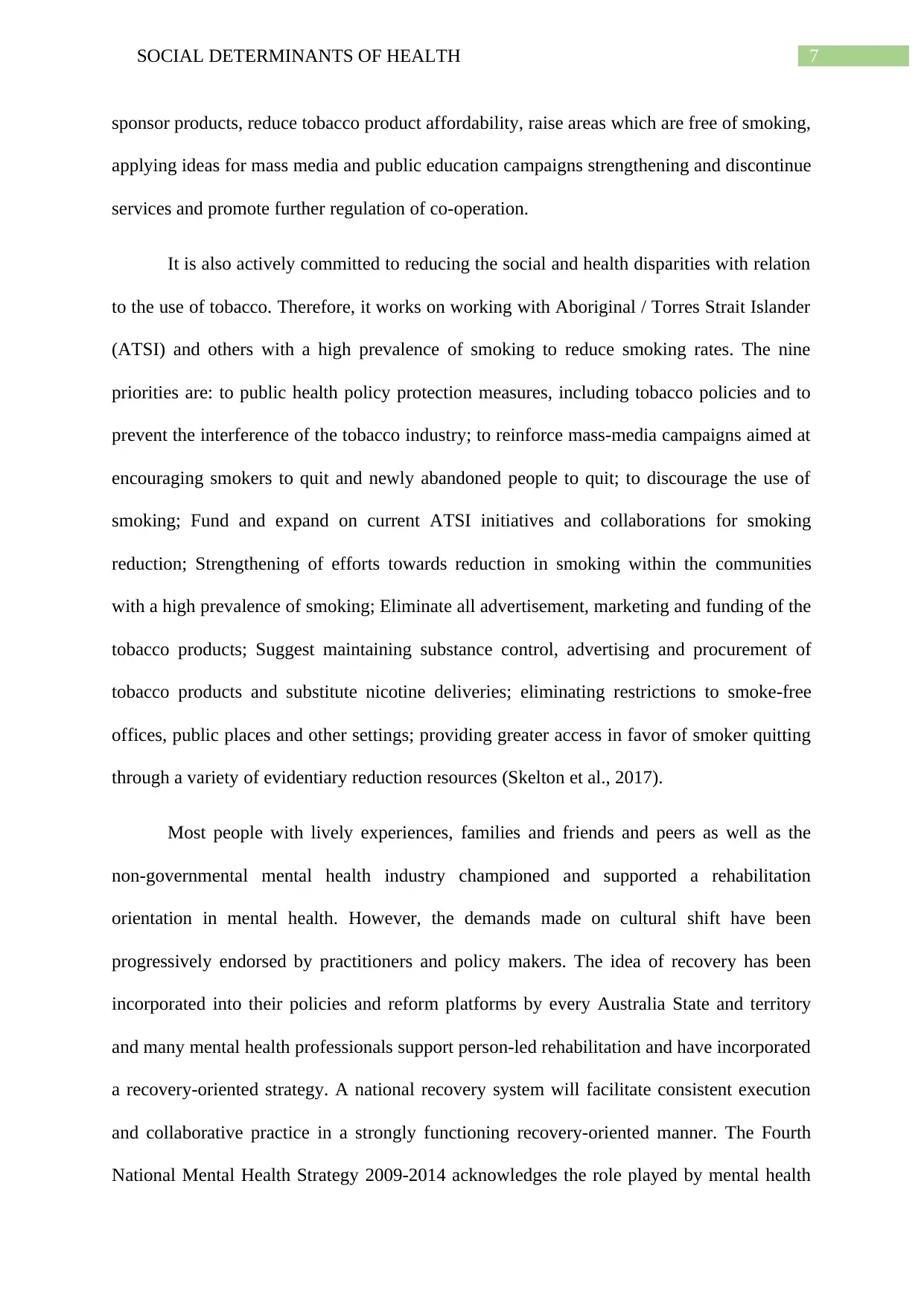
7SOCIAL DETERMINANTS OF HEALTH
sponsor products, reduce tobacco product affordability, raise areas which are free of smoking,
applying ideas for mass media and public education campaigns strengthening and discontinue
services and promote further regulation of co-operation.
It is also actively committed to reducing the social and health disparities with relation
to the use of tobacco. Therefore, it works on working with Aboriginal / Torres Strait Islander
(ATSI) and others with a high prevalence of smoking to reduce smoking rates. The nine
priorities are: to public health policy protection measures, including tobacco policies and to
prevent the interference of the tobacco industry; to reinforce mass-media campaigns aimed at
encouraging smokers to quit and newly abandoned people to quit; to discourage the use of
smoking; Fund and expand on current ATSI initiatives and collaborations for smoking
reduction; Strengthening of efforts towards reduction in smoking within the communities
with a high prevalence of smoking; Eliminate all advertisement, marketing and funding of the
tobacco products; Suggest maintaining substance control, advertising and procurement of
tobacco products and substitute nicotine deliveries; eliminating restrictions to smoke-free
offices, public places and other settings; providing greater access in favor of smoker quitting
through a variety of evidentiary reduction resources (Skelton et al., 2017).
Most people with lively experiences, families and friends and peers as well as the
non-governmental mental health industry championed and supported a rehabilitation
orientation in mental health. However, the demands made on cultural shift have been
progressively endorsed by practitioners and policy makers. The idea of recovery has been
incorporated into their policies and reform platforms by every Australia State and territory
and many mental health professionals support person-led rehabilitation and have incorporated
a recovery-oriented strategy. A national recovery system will facilitate consistent execution
and collaborative practice in a strongly functioning recovery-oriented manner. The Fourth
National Mental Health Strategy 2009-2014 acknowledges the role played by mental health
sponsor products, reduce tobacco product affordability, raise areas which are free of smoking,
applying ideas for mass media and public education campaigns strengthening and discontinue
services and promote further regulation of co-operation.
It is also actively committed to reducing the social and health disparities with relation
to the use of tobacco. Therefore, it works on working with Aboriginal / Torres Strait Islander
(ATSI) and others with a high prevalence of smoking to reduce smoking rates. The nine
priorities are: to public health policy protection measures, including tobacco policies and to
prevent the interference of the tobacco industry; to reinforce mass-media campaigns aimed at
encouraging smokers to quit and newly abandoned people to quit; to discourage the use of
smoking; Fund and expand on current ATSI initiatives and collaborations for smoking
reduction; Strengthening of efforts towards reduction in smoking within the communities
with a high prevalence of smoking; Eliminate all advertisement, marketing and funding of the
tobacco products; Suggest maintaining substance control, advertising and procurement of
tobacco products and substitute nicotine deliveries; eliminating restrictions to smoke-free
offices, public places and other settings; providing greater access in favor of smoker quitting
through a variety of evidentiary reduction resources (Skelton et al., 2017).
Most people with lively experiences, families and friends and peers as well as the
non-governmental mental health industry championed and supported a rehabilitation
orientation in mental health. However, the demands made on cultural shift have been
progressively endorsed by practitioners and policy makers. The idea of recovery has been
incorporated into their policies and reform platforms by every Australia State and territory
and many mental health professionals support person-led rehabilitation and have incorporated
a recovery-oriented strategy. A national recovery system will facilitate consistent execution
and collaborative practice in a strongly functioning recovery-oriented manner. The Fourth
National Mental Health Strategy 2009-2014 acknowledges the role played by mental health
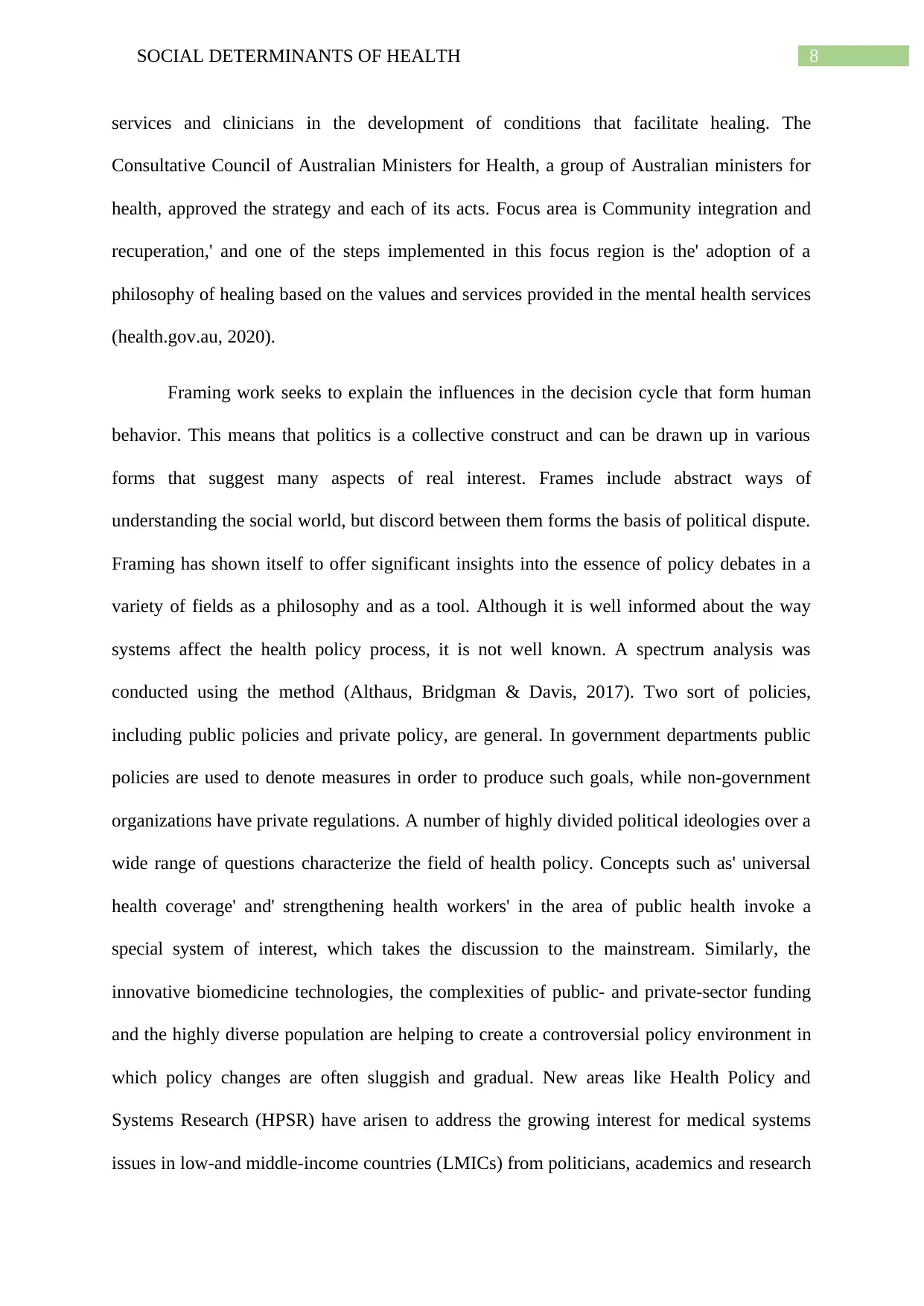
8SOCIAL DETERMINANTS OF HEALTH
services and clinicians in the development of conditions that facilitate healing. The
Consultative Council of Australian Ministers for Health, a group of Australian ministers for
health, approved the strategy and each of its acts. Focus area is Community integration and
recuperation,' and one of the steps implemented in this focus region is the' adoption of a
philosophy of healing based on the values and services provided in the mental health services
(health.gov.au, 2020).
Framing work seeks to explain the influences in the decision cycle that form human
behavior. This means that politics is a collective construct and can be drawn up in various
forms that suggest many aspects of real interest. Frames include abstract ways of
understanding the social world, but discord between them forms the basis of political dispute.
Framing has shown itself to offer significant insights into the essence of policy debates in a
variety of fields as a philosophy and as a tool. Although it is well informed about the way
systems affect the health policy process, it is not well known. A spectrum analysis was
conducted using the method (Althaus, Bridgman & Davis, 2017). Two sort of policies,
including public policies and private policy, are general. In government departments public
policies are used to denote measures in order to produce such goals, while non-government
organizations have private regulations. A number of highly divided political ideologies over a
wide range of questions characterize the field of health policy. Concepts such as' universal
health coverage' and' strengthening health workers' in the area of public health invoke a
special system of interest, which takes the discussion to the mainstream. Similarly, the
innovative biomedicine technologies, the complexities of public- and private-sector funding
and the highly diverse population are helping to create a controversial policy environment in
which policy changes are often sluggish and gradual. New areas like Health Policy and
Systems Research (HPSR) have arisen to address the growing interest for medical systems
issues in low-and middle-income countries (LMICs) from politicians, academics and research
services and clinicians in the development of conditions that facilitate healing. The
Consultative Council of Australian Ministers for Health, a group of Australian ministers for
health, approved the strategy and each of its acts. Focus area is Community integration and
recuperation,' and one of the steps implemented in this focus region is the' adoption of a
philosophy of healing based on the values and services provided in the mental health services
(health.gov.au, 2020).
Framing work seeks to explain the influences in the decision cycle that form human
behavior. This means that politics is a collective construct and can be drawn up in various
forms that suggest many aspects of real interest. Frames include abstract ways of
understanding the social world, but discord between them forms the basis of political dispute.
Framing has shown itself to offer significant insights into the essence of policy debates in a
variety of fields as a philosophy and as a tool. Although it is well informed about the way
systems affect the health policy process, it is not well known. A spectrum analysis was
conducted using the method (Althaus, Bridgman & Davis, 2017). Two sort of policies,
including public policies and private policy, are general. In government departments public
policies are used to denote measures in order to produce such goals, while non-government
organizations have private regulations. A number of highly divided political ideologies over a
wide range of questions characterize the field of health policy. Concepts such as' universal
health coverage' and' strengthening health workers' in the area of public health invoke a
special system of interest, which takes the discussion to the mainstream. Similarly, the
innovative biomedicine technologies, the complexities of public- and private-sector funding
and the highly diverse population are helping to create a controversial policy environment in
which policy changes are often sluggish and gradual. New areas like Health Policy and
Systems Research (HPSR) have arisen to address the growing interest for medical systems
issues in low-and middle-income countries (LMICs) from politicians, academics and research
⊘ This is a preview!⊘
Do you want full access?
Subscribe today to unlock all pages.

Trusted by 1+ million students worldwide
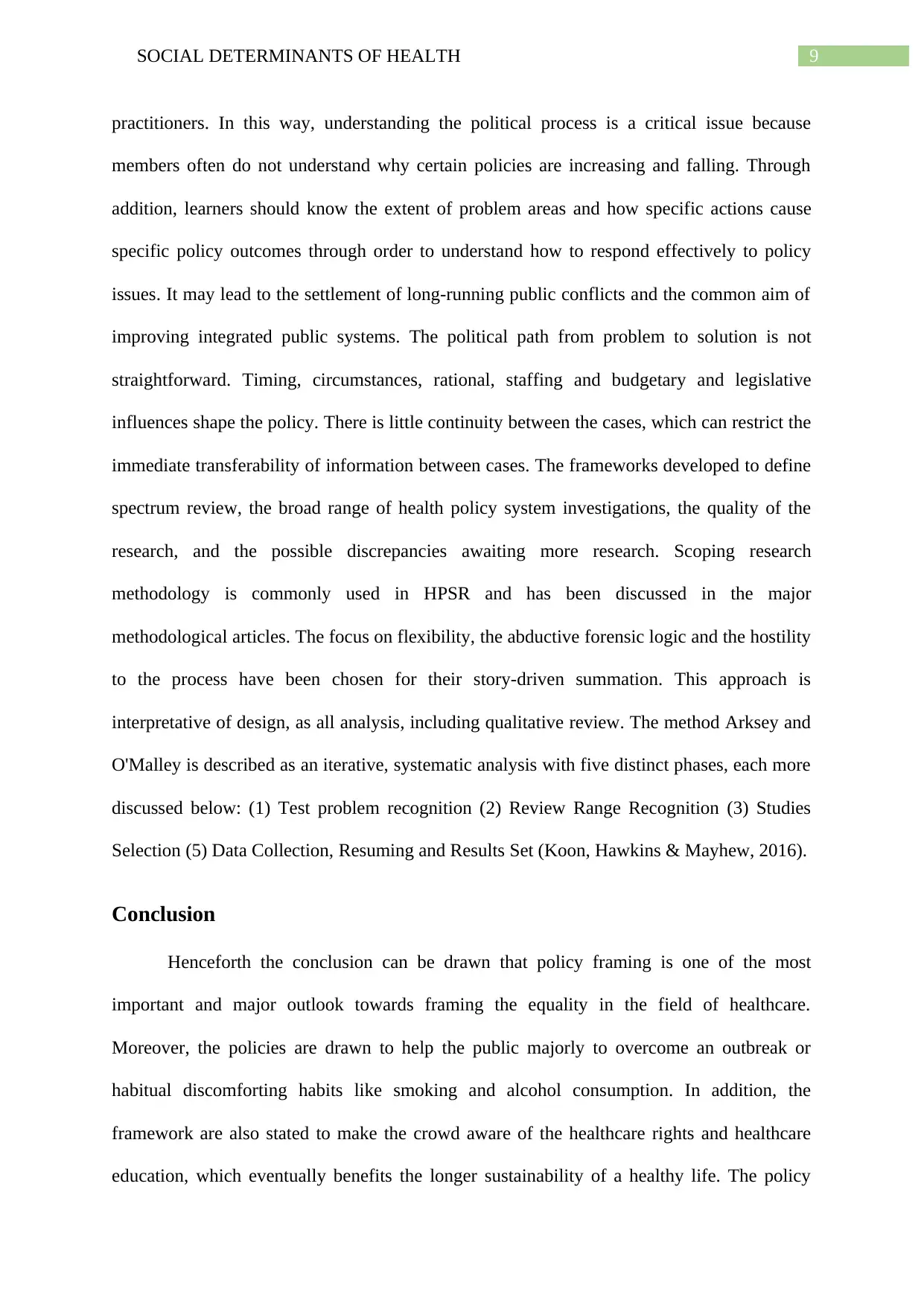
9SOCIAL DETERMINANTS OF HEALTH
practitioners. In this way, understanding the political process is a critical issue because
members often do not understand why certain policies are increasing and falling. Through
addition, learners should know the extent of problem areas and how specific actions cause
specific policy outcomes through order to understand how to respond effectively to policy
issues. It may lead to the settlement of long-running public conflicts and the common aim of
improving integrated public systems. The political path from problem to solution is not
straightforward. Timing, circumstances, rational, staffing and budgetary and legislative
influences shape the policy. There is little continuity between the cases, which can restrict the
immediate transferability of information between cases. The frameworks developed to define
spectrum review, the broad range of health policy system investigations, the quality of the
research, and the possible discrepancies awaiting more research. Scoping research
methodology is commonly used in HPSR and has been discussed in the major
methodological articles. The focus on flexibility, the abductive forensic logic and the hostility
to the process have been chosen for their story-driven summation. This approach is
interpretative of design, as all analysis, including qualitative review. The method Arksey and
O'Malley is described as an iterative, systematic analysis with five distinct phases, each more
discussed below: (1) Test problem recognition (2) Review Range Recognition (3) Studies
Selection (5) Data Collection, Resuming and Results Set (Koon, Hawkins & Mayhew, 2016).
Conclusion
Henceforth the conclusion can be drawn that policy framing is one of the most
important and major outlook towards framing the equality in the field of healthcare.
Moreover, the policies are drawn to help the public majorly to overcome an outbreak or
habitual discomforting habits like smoking and alcohol consumption. In addition, the
framework are also stated to make the crowd aware of the healthcare rights and healthcare
education, which eventually benefits the longer sustainability of a healthy life. The policy
practitioners. In this way, understanding the political process is a critical issue because
members often do not understand why certain policies are increasing and falling. Through
addition, learners should know the extent of problem areas and how specific actions cause
specific policy outcomes through order to understand how to respond effectively to policy
issues. It may lead to the settlement of long-running public conflicts and the common aim of
improving integrated public systems. The political path from problem to solution is not
straightforward. Timing, circumstances, rational, staffing and budgetary and legislative
influences shape the policy. There is little continuity between the cases, which can restrict the
immediate transferability of information between cases. The frameworks developed to define
spectrum review, the broad range of health policy system investigations, the quality of the
research, and the possible discrepancies awaiting more research. Scoping research
methodology is commonly used in HPSR and has been discussed in the major
methodological articles. The focus on flexibility, the abductive forensic logic and the hostility
to the process have been chosen for their story-driven summation. This approach is
interpretative of design, as all analysis, including qualitative review. The method Arksey and
O'Malley is described as an iterative, systematic analysis with five distinct phases, each more
discussed below: (1) Test problem recognition (2) Review Range Recognition (3) Studies
Selection (5) Data Collection, Resuming and Results Set (Koon, Hawkins & Mayhew, 2016).
Conclusion
Henceforth the conclusion can be drawn that policy framing is one of the most
important and major outlook towards framing the equality in the field of healthcare.
Moreover, the policies are drawn to help the public majorly to overcome an outbreak or
habitual discomforting habits like smoking and alcohol consumption. In addition, the
framework are also stated to make the crowd aware of the healthcare rights and healthcare
education, which eventually benefits the longer sustainability of a healthy life. The policy
Paraphrase This Document
Need a fresh take? Get an instant paraphrase of this document with our AI Paraphraser
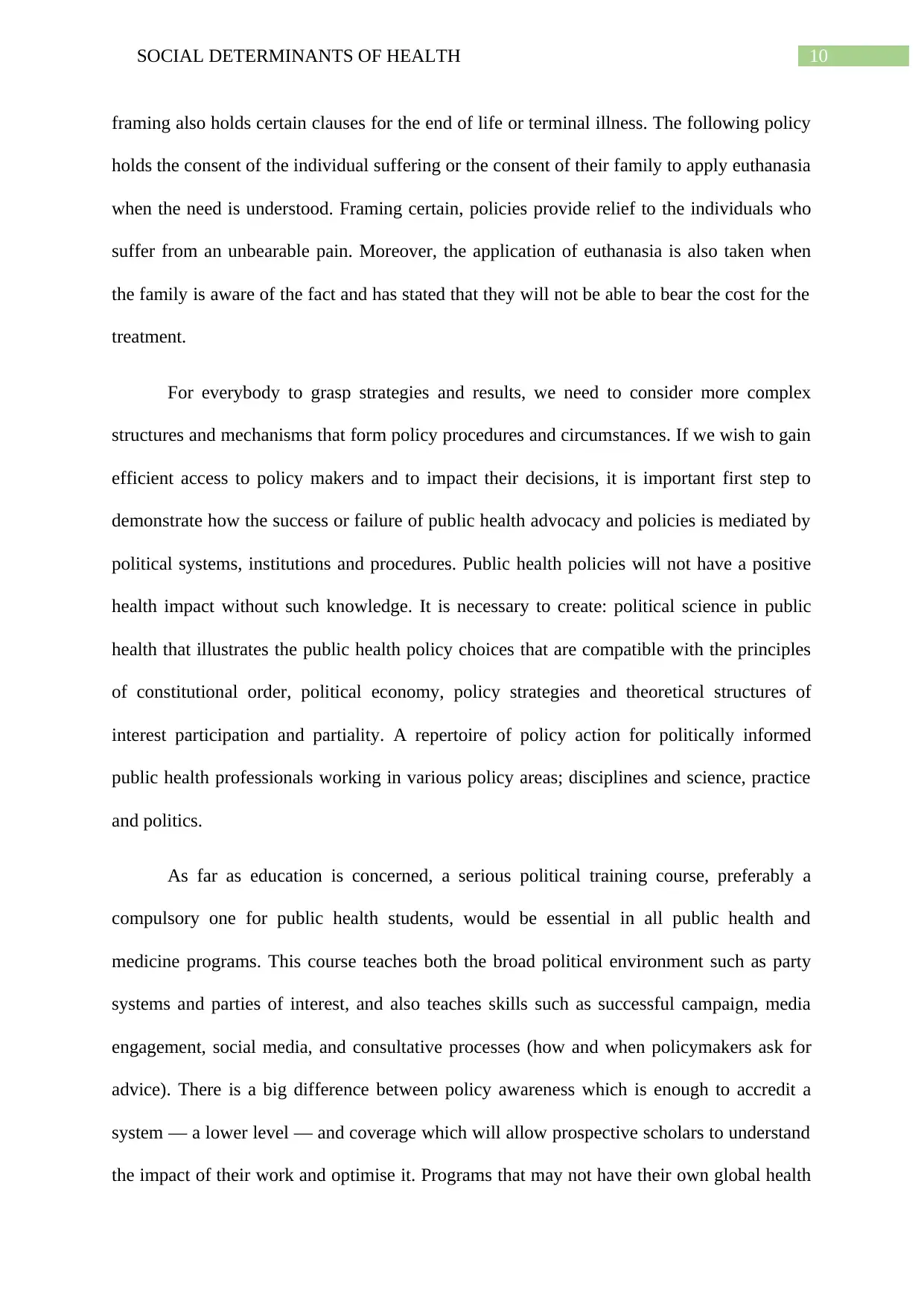
10SOCIAL DETERMINANTS OF HEALTH
framing also holds certain clauses for the end of life or terminal illness. The following policy
holds the consent of the individual suffering or the consent of their family to apply euthanasia
when the need is understood. Framing certain, policies provide relief to the individuals who
suffer from an unbearable pain. Moreover, the application of euthanasia is also taken when
the family is aware of the fact and has stated that they will not be able to bear the cost for the
treatment.
For everybody to grasp strategies and results, we need to consider more complex
structures and mechanisms that form policy procedures and circumstances. If we wish to gain
efficient access to policy makers and to impact their decisions, it is important first step to
demonstrate how the success or failure of public health advocacy and policies is mediated by
political systems, institutions and procedures. Public health policies will not have a positive
health impact without such knowledge. It is necessary to create: political science in public
health that illustrates the public health policy choices that are compatible with the principles
of constitutional order, political economy, policy strategies and theoretical structures of
interest participation and partiality. A repertoire of policy action for politically informed
public health professionals working in various policy areas; disciplines and science, practice
and politics.
As far as education is concerned, a serious political training course, preferably a
compulsory one for public health students, would be essential in all public health and
medicine programs. This course teaches both the broad political environment such as party
systems and parties of interest, and also teaches skills such as successful campaign, media
engagement, social media, and consultative processes (how and when policymakers ask for
advice). There is a big difference between policy awareness which is enough to accredit a
system — a lower level — and coverage which will allow prospective scholars to understand
the impact of their work and optimise it. Programs that may not have their own global health
framing also holds certain clauses for the end of life or terminal illness. The following policy
holds the consent of the individual suffering or the consent of their family to apply euthanasia
when the need is understood. Framing certain, policies provide relief to the individuals who
suffer from an unbearable pain. Moreover, the application of euthanasia is also taken when
the family is aware of the fact and has stated that they will not be able to bear the cost for the
treatment.
For everybody to grasp strategies and results, we need to consider more complex
structures and mechanisms that form policy procedures and circumstances. If we wish to gain
efficient access to policy makers and to impact their decisions, it is important first step to
demonstrate how the success or failure of public health advocacy and policies is mediated by
political systems, institutions and procedures. Public health policies will not have a positive
health impact without such knowledge. It is necessary to create: political science in public
health that illustrates the public health policy choices that are compatible with the principles
of constitutional order, political economy, policy strategies and theoretical structures of
interest participation and partiality. A repertoire of policy action for politically informed
public health professionals working in various policy areas; disciplines and science, practice
and politics.
As far as education is concerned, a serious political training course, preferably a
compulsory one for public health students, would be essential in all public health and
medicine programs. This course teaches both the broad political environment such as party
systems and parties of interest, and also teaches skills such as successful campaign, media
engagement, social media, and consultative processes (how and when policymakers ask for
advice). There is a big difference between policy awareness which is enough to accredit a
system — a lower level — and coverage which will allow prospective scholars to understand
the impact of their work and optimise it. Programs that may not have their own global health
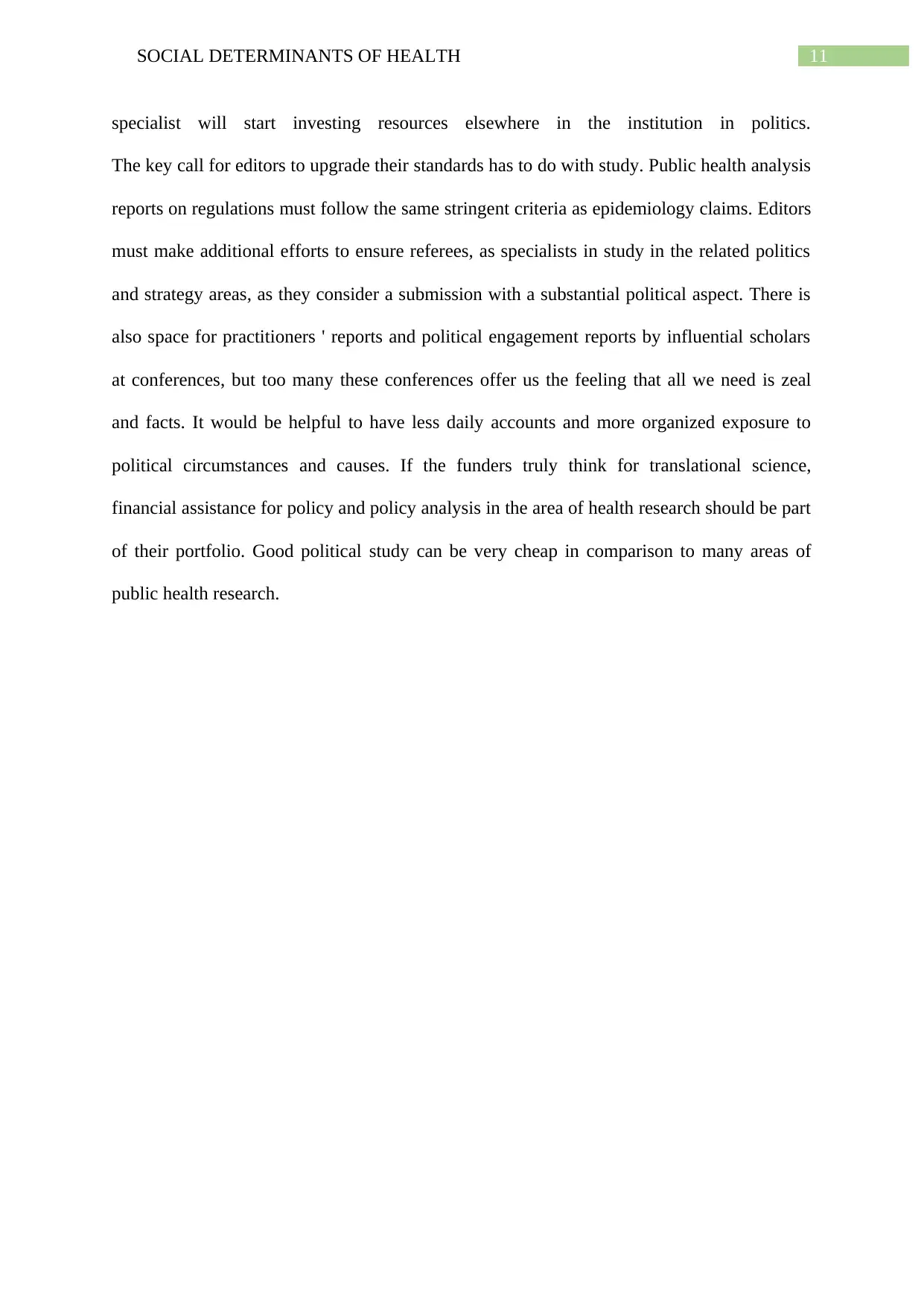
11SOCIAL DETERMINANTS OF HEALTH
specialist will start investing resources elsewhere in the institution in politics.
The key call for editors to upgrade their standards has to do with study. Public health analysis
reports on regulations must follow the same stringent criteria as epidemiology claims. Editors
must make additional efforts to ensure referees, as specialists in study in the related politics
and strategy areas, as they consider a submission with a substantial political aspect. There is
also space for practitioners ' reports and political engagement reports by influential scholars
at conferences, but too many these conferences offer us the feeling that all we need is zeal
and facts. It would be helpful to have less daily accounts and more organized exposure to
political circumstances and causes. If the funders truly think for translational science,
financial assistance for policy and policy analysis in the area of health research should be part
of their portfolio. Good political study can be very cheap in comparison to many areas of
public health research.
specialist will start investing resources elsewhere in the institution in politics.
The key call for editors to upgrade their standards has to do with study. Public health analysis
reports on regulations must follow the same stringent criteria as epidemiology claims. Editors
must make additional efforts to ensure referees, as specialists in study in the related politics
and strategy areas, as they consider a submission with a substantial political aspect. There is
also space for practitioners ' reports and political engagement reports by influential scholars
at conferences, but too many these conferences offer us the feeling that all we need is zeal
and facts. It would be helpful to have less daily accounts and more organized exposure to
political circumstances and causes. If the funders truly think for translational science,
financial assistance for policy and policy analysis in the area of health research should be part
of their portfolio. Good political study can be very cheap in comparison to many areas of
public health research.
⊘ This is a preview!⊘
Do you want full access?
Subscribe today to unlock all pages.

Trusted by 1+ million students worldwide
1 out of 14
Related Documents
Your All-in-One AI-Powered Toolkit for Academic Success.
+13062052269
info@desklib.com
Available 24*7 on WhatsApp / Email
![[object Object]](/_next/static/media/star-bottom.7253800d.svg)
Unlock your academic potential
Copyright © 2020–2025 A2Z Services. All Rights Reserved. Developed and managed by ZUCOL.





